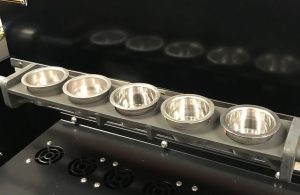What is a Platinum Mouldable Fusion Machine?
The sample preparation for XRF analysis is typically prepared by mixing a ratio of lithium tetraborate and lithium metaborate with a pulverised sample. The mixture is heated in an electric or gas fusion machine, and agitated until the sample is fully dissolved in the flux. At the end of the cycle the automated fusion machine pours the molten mixture from the platinum crucible into the platinum mould, which once cooled, is set into a glass disc. This process is known as lithium tetraborate fusion. The prepared sample is then able to be presented to the x-ray machine for analysis.

In some industries a combination vessel known as a platinum Mouldable is used as a replacement for the platinum crucible and mould. The platinum Mouldable, is generally made from 95% platinum and 5% gold, weighing from 100 to 150 grams, depending on the bead size and durability required. Similar to the crucible process, the flux and sample mixture is put inside the platinum mouldable for fusion and agitation in the fusion machine. At the end of the fusion process, the mouldable is automatically removed from the heating source and cooled using fans, compressed air or blowers. The bead is then able to be cooled inside the mouldable itself, as the bottom surface of the mouldable is analytically flat.
Often release agents should be added to the fusion recipe, to ensure proper release of the glass bead from the mouldable, to minimize damage to the bottom analytical surface. Whilst not appropriate for all sample types, mouldables are commonly found in XRF laboratories in the iron ore and aluminium mining sectors.
Platinum Mouldable Products available from XRF Scientific
For further details on the mouldable fusion machines on offer from XRF Scientific, please visit here. For details of the platinum mouldables available, please visit here or contact us to discuss your requirements.









